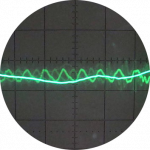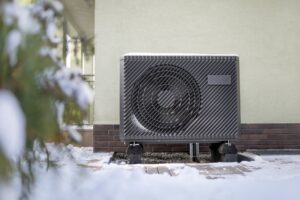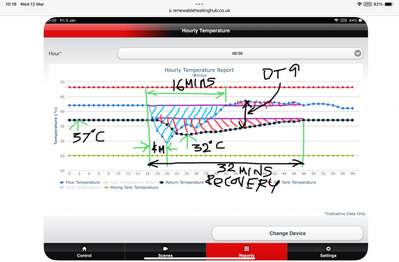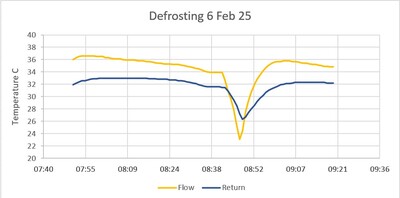Volumisers in Heat Pump Systems: Does Placement Matter?
The debate over buffer tanks in heat pump systems has been a hot topic for years, but there’s another component that’s equally important yet often overlooked: the volumiser. While buffer tanks are designed to store and release heat energy, volumisers serve a different purpose: they store water volume to stabilise flow rates and prevent short-cycling. However, just like buffer tanks, it appears the placement of volumisers is a point of contention among installers and heat engineers.
Recently, I posed a question to my network of heat pump installers, engineers and experts: “Where do you place the volumiser: on the flow side return side?” The results were striking: 81% said the return side, 8% said the flow side, and 11% offered other suggestions, often with comments like “it’s needed at all if the system is correctly designed”.
While the majority opinion is clear, it raises an important question: Is this placement based on sound technical reasoning, or is it simply a case of following tradition?
What Is a Volumiser & What Does It Do?
A volumiser is a hydraulic component that stores water volume to stabilise flow rates in a heat pump system. Its primary role is to prevent short-cycling (frequent on/off cycling of the heat pump) and to ensure smooth operation during transient events, such as defrost cycles.
Unlike a buffer tank, which stores heat energy, a volumiser doesn’t store temperature. It stores volume. This distinction is crucial because it determines how the volumiser interacts with the system and where it should be placed for maximum effectiveness.
The Defrost Cycle: A Critical Consideration
To understand why volumiser placement matters, we need to look at what happens during a defrost cycle. When a heat pump defrosts, it temporarily reverses its operation to melt ice on the outdoor coil. This process introduces cold water into the heating circuit, which can disrupt comfort and system performance if not managed properly.
If the Volumiser is on the Return Side:
- During defrost, the heat pump introduces colder water into the flow pipe, which then circulates through the emitters. If a volumiser is installed on the return, it offers no thermal buffering… by the time the water reaches it, the cold slug has already passed through the radiators. This can cause a noticeable drop in room comfort.
- This cold water mixes with the cooler return water, further reducing the temperature entering the radiators.
- Result: Radiators can receive a sudden influx of colder water, causing potential cooling and discomfort.
If the Volumiser is on the Flow Side:
- Cold water from defrost enters the flow side, where it mixes with warmer water stored in the volumiser (heated by the heat pump during normal operation).
- The volumiser’s stored volume moderates the temperature of the cold influx before it reaches the radiators.
- Result: Radiators receive tempered water, minimising temperature shocks and maintaining comfort.
Thermodynamics and Energy Efficiency
The flow-side placement of the volumiser aligns with thermodynamic principles, particularly the First Law of Thermodynamics (conservation of energy). By moderating cold influxes during defrost, the flow-side volumiser reduces the energy required to reheat the system, improving overall efficiency.
On the return side, the volumiser’s stored energy does little to moderate the cold influx, as the return water is already cooler. This means the radiators receive colder water almost immediately, increasing the energy required to reheat the system and reducing efficiency.
Why the Majority Might Be Wrong
Given the technical advantages of flow-side placement, why do 81% of installers prefer the return side? The answer likely lies in tradition and training. Many installers are taught to place volumisers on the return side because it’s seen as the “standard” approach. But is that right?
What Homeowners Need to Know
As a homeowner, understanding the role and placement of volumisers can help you have more informed conversations with your installer. Here are a few key points to keep in mind:
- Ask About Volumiser Placement: If your installer plans to include a volumiser, ask where they intend to place it. If they say the return side, ask why and discuss the benefits of flow-side placement.
- Focus on Defrost Performance: A well-placed volumiser can improve comfort during defrost cycles by preventing cold shocks to the radiators.
- Consider System Efficiency: Flow-side placement can reduce energy consumption and improve overall system efficiency, saving you money in the long run.
Get a copy of The Ultimate Guide to Heat Pumps
Subscribe and follow our YouTube channel!
Whilst I agree with the final conclusion (flow side placement appears to be best, perhaps with the exception that if the volumiser is outside the insulated envelope of the house there might be a loss argument for return side placement) I am not sure about the following:
Posted by: @editorThe flow-side placement of the volumiser aligns with thermodynamic principles, particularly the First Law of Thermodynamics (conservation of energy). By moderating cold influxes during defrost, the flow-side volumiser reduces the energy required to reheat the system, improving overall efficiency.
Can you explain why that is the case please. The energy used for the actual defrost is (surely) the same either way and so its this amount of energy that must be replaced by the heat pump. So (surely) for the statement to be true it would need the heat pump, for some reason, to operate more efficiently during recovery in flow side placement than it would in return side placement. Why would that be?
4kW peak of solar PV since 2011; EV and a 1930s house which has been partially renovated to improve its efficiency. 7kW Vaillant heat pump.
@jamespa the key point, from my own logical thought process (which could be flawed), is where and how the cold influx from defrost interacts with the system. When the volumiser is on the flow side, it contains warmer water from prior heating cycles. During defrost, this stored warmth moderates the cold influx, reducing the temperature drop in the water entering the radiators. This means the heat pump doesn’t have to work as hard to reheat the system after defrost, as the temperature difference it needs to overcome is smaller.
On the return side, the volumiser’s stored energy is less effective (in my opinion) because the return water is already cooler. Cold water from defrost mixes with this cooler water, creating a larger temperature drop inside the property. This forces the heat pump to work harder to reheat the system, consuming more energy in the process.
While the energy used for the actual defrost is indeed the same in both cases, the recovery phase is where I think the difference lies. By moderating the cold influx, the flow-side volumiser reduces the energy required to bring the system back to its target temperature, improving overall efficiency.
Get a copy of The Ultimate Guide to Heat Pumps
Subscribe and follow our YouTube channel!
Posted by: @editorWhen the volumiser is on the flow side, it contains warmer water from prior heating cycles. During defrost, this stored warmth moderates the cold influx, reducing the temperature drop in the water entering the radiators. This means the heat pump doesn’t have to work as hard to reheat the system after defrost, as the temperature difference it needs to overcome is smaller
Not sure about this. The heat pump sees the water returning from the fins, which will be at a temperature determined by the defrost process not any temperature of water being sent to the radiators.
Posted by: @editorOn the return side, the volumiser’s stored energy is less effective (in my opinion) because the return water is already cooler. Cold water from defrost mixes with this cooler water, creating a larger temperature drop inside the property.
It certainly stores less energy. But its the same amount of energy that has to be made up (ie the energy needed for defrost).
Posted by: @editorthe recovery phase is where I think the difference lies.
agree!
Posted by: @editorBy moderating the cold influx, the flow-side volumiser reduces the energy required to bring the system back to its target temperature, improving overall efficiency.
Back to the first point, not sure!
probably not worth an extended argument since we agree on the conclusions!
4kW peak of solar PV since 2011; EV and a 1930s house which has been partially renovated to improve its efficiency. 7kW Vaillant heat pump.
Posted by: @editorWhen the volumiser is on the flow side, it contains warmer water from prior heating cycles. During defrost, this stored warmth moderates the cold influx, reducing the temperature drop in the water entering the radiators. This means the heat pump doesn’t have to work as hard to reheat the system after defrost, as the temperature difference it needs to overcome is smaller
Not sure about this. The heat pump sees the water returning from the fins, which will be at a temperature determined by the defrost process not any temperature of water being sent to the radiators.
Posted by: @editorOn the return side, the volumiser’s stored energy is less effective (in my opinion) because the return water is already cooler. Cold water from defrost mixes with this cooler water, creating a larger temperature drop inside the property.
It certainly stores less energy. But its the same amount of energy that has to be made up (ie the energy needed for defrost).
Posted by: @editorthe recovery phase is where I think the difference lies.
agree!
Posted by: @editorBy moderating the cold influx, the flow-side volumiser reduces the energy required to bring the system back to its target temperature, improving overall efficiency.
Back to the first point, not sure!
probably not worth an extended argument since we agree on the conclusions!
4kW peak of solar PV since 2011; EV and a 1930s house which has been partially renovated to improve its efficiency. 7kW Vaillant heat pump.
@jamespa Agreed. I think it’s a case of much over muchness, which is probably why the industry doesn’t pay too much attention to it. That said, when we eventually redo our piping to switch from a buffer to a volumiser, I’ll request it to be placed on the flow side. The reason I've posted this is because there have been questions from homeowners on this in the comments of our Youtube videos.
Get a copy of The Ultimate Guide to Heat Pumps
Subscribe and follow our YouTube channel!
@editor I have been persuaded by the argument that you have been stating that the correct placement for the volumiser should indeed be on the flow side. Im also not so sure it’s quite that trivial to the point that it doesn’t matter.
The key reason for proposing a volumiser has been to aid with recovery following a defrost. And therefore imo it would be absolutely imperative to start the mixing of the cold slug of defrost water as soon as possible and - crucially- before the water even enters the radiator/emitter network.
firstly the benefit of the volumiser is that it adds 25% more water to the system.
secondly it is a store of primary flow temp water
That means the hotter water in the volumiser is immediately diluting the cold water slug with a surplus reserve of water. The only issue I see is how much will it mix with the cold slug before the hot tank is all drained out.
I say the volumiser is not a trivial question because defrosting doesn’t come once in a while. They are usually repeat, repeat, repeat incidents of disruption to the steady flow/return through the emitters. Taking maybe 30 minutes to recover from.
you have to pictures the event en-mas.
here is my interpretation of the losses needing to be corrected
take what you will from this sketch. The importance of steady state is the key to an early recovery annd this is achieved by the earliest possible mixing of the defrost slug imo.
I've got a 7kW Arotherm+ with 50 L buffer tank (so no immediate slug of cold water going to the radiators) and see the recovery from defrosting as only taking a few minutes with the heat pump temporarily producing more heat than before the defrosting started. The output then drops again as the ice builds up. These temperatures were measured close to the buffer tank. The OAT was around -0.5C. The heat pump stopped producing heat for 6 minutes and the flow temperature was back to the defrosting temperature after a further 7 minutes. I've not been in the right place at the right time to observe if the circulating pump for the radiators is automatically stopped during defrosting but, at the normal heat pump flow rate the water through the heat pump during 6 minutes is 2.4 x the buffer tank volume.
Posted by: @johnrI've not been in the right place at the right time to observe if the circulating pump for the radiators is automatically stopped during defrosting but, at the normal heat pump flow rate the water through the heat pump during 6 minutes is 2.4 x the buffer tank volume.
The normal process is for the circulating pumps to continue running, as they need to circulate warm water from the radiators (or DHW) to the heat pump, where the heat pump operates 'in reverse', extracting heat from the warm water to warm itself and melt any ice that has formed. Once the heat has been extracted, this cooled/colder water is then continues it's journey back into the property, hence the slug of cold water entering the radiators.
Playing devil's advocate for a moment - it strikes me that everyone is looking at this from the viewpoint of protecting the heating system from that slug of cold water, not from the viewpoint of defrosting the heat pump which will require a certain volume of warm water. The purpose of the volumiser is to ensure that sufficient volume of warm water exists. If it is immediately diluted by the ingress of cold water, then the volume of warm water available for the defrost cycle is diminished. Or to put it another way - what is the primary purpose of the volumiser, or why did you install a volumiser? Was it to provide sufficient volume for effective defrost cycles, or was it to protect the heating system from the ingress of cold water following a defrost cycle? If it was the former, then that would suggest the return may be the better placement?
Samsung 12kW gen6 ASHP with 50L volumiser and all new large radiators. 7.2kWp solar (south facing), Tesla PW3 (13.5kW)
Solar generation completely offsets ASHP usage annually. We no longer burn ~1600L of kerosene annually.
Posted by: @old_scientistThe purpose of the volumiser is to ensure that sufficient volume of warm water exists. If it is immediately diluted by the ingress of cold water, then the volume of warm water available for the defrost cycle is diminished. Or to put it another way - what is the primary purpose of the volumiser, or why did you install a volumiser? Was it to provide sufficient volume for effective defrost cycles, or was it to protect the heating system from the ingress of cold water following a defrost cycle? If it was the former, then that would suggest the return may be the better placement?
That’s a really good question. Ive been trying to find a clearer explanation of what specifically is the purpose or effect of increased volume in the heating circuit. For a while now I personally have seen that the amount of heat to defrost isn’t that great since it only takes around 4 minutes and this appears to be Bourne out by our system inbuilt temperature control which only tries to maintain 20c minimum water temperature through it’s freeze stat function. The recent discussions which you’ve been involved with have brought new other insights that it’s more about recovery time to get the flow and return back up to temperature to reinstate heat transfer through the emitters.
just for clarity, my post above shows our HP system which does not have a volumiser or a buffer tank which is why the recovery takes over 30 minutes. But the return temp only drops by 5c. But what I’m suggesting is that with repeated defrosts and a drop of 5c and a recovery of 30 minutes every hour this will have a disruptive effect on maintaining steady state heat transfer into the living space. This might be more pronounced in colder climates.
There may also be other ways of adding volume to help with defrosts which might be more effective than a volumiser, like perhaps simply adding more radiator volume in the first place. This would also have the added function of allowing systems to operate at lower flow temperatures making them more efficient.
Also it’s interesting to see how @johnr and the buffer tank he has fitted reacts to a defrost.
Posted by: @sunandairPosted by: @old_scientistThe purpose of the volumiser is to ensure that sufficient volume of warm water exists. If it is immediately diluted by the ingress of cold water, then the volume of warm water available for the defrost cycle is diminished. Or to put it another way - what is the primary purpose of the volumiser, or why did you install a volumiser? Was it to provide sufficient volume for effective defrost cycles, or was it to protect the heating system from the ingress of cold water following a defrost cycle? If it was the former, then that would suggest the return may be the better placement?
That’s a really good question. Ive been trying to find a clearer explanation of what specifically is the purpose or effect of increased volume in the heating circuit. For a while now I personally have seen that the amount of heat to defrost isn’t that great since it only takes around 4 minutes and this appears to be Bourne out by our system inbuilt temperature control which only tries to maintain 20c minimum water temperature through it’s freeze stat function. The recent discussions which you’ve been involved with have brought new other insights that it’s more about recovery time to get the flow and return back up to temperature to reinstate heat transfer through the emitters.
just for clarity, my post above shows our HP system which does not have a volumiser or a buffer tank which is why the recovery takes over 30 minutes. But the return temp only drops by 5c. But what I’m suggesting is that with repeated defrosts and a drop of 5c and a recovery of 30 minutes every hour this will have a disruptive effect on maintaining steady state heat transfer into the living space. This might be more pronounced in colder climates.
There may also be other ways of adding volume to help with defrosts which might be more effective than a volumiser, like perhaps simply adding more radiator volume in the first place. This would also have the added function of allowing systems to operate at lower flow temperatures making them more efficient.
Also it’s interesting to see how @johnr and the buffer tank he has fitted reacts to a defrost.
It is indeed a good question.
The purpose is always said to be to ensure that there is sufficient water in the system to yield sufficient energy to effect the defrost. If there isnt sufficient energy available then the heat pump cant recover, and may either be damaged or (more hopefully) will shut itself down. Some heat pumps will activate a backup electric heater in this case, or indeed always for defrost.
There is a thread here where this behaviour is actually observed (and is a problem!) and the heat pump does indeed shut itself down, triggered by a return temperature of <15C. In this particular case the problem only occurs during DHW reheat following the drawing of a bath - which may be an argument for putting the volumiser in the flow before the diverter valve not afterwards return common return!
I am guessing that heat pump designers consider the something close to the worst case when recommending minimum system volume which would be a system operating at a particularly low flow temperature, eg a small UFH based system with dense UFH pipes. Obviously if the system is operating at a higher flow temperature, such as is likely with radiators, the energy stored in the water is correspondingly higher so less volume is required.
Obviously adding more radiator capacity is a 'more' efficient way to add more system volume, but radiator sizing is frequently limited by practicality!
Repeated defrosts surely do have an effect on average output, and some manufacturers (eg Mitsubishi) produce two tables of output vs OAT/FT, one including the effect of defrost and one excluding it. What assumptions they make about humidity and thus frequency of defrost, and other important parameters, is anyone's guess.
4kW peak of solar PV since 2011; EV and a 1930s house which has been partially renovated to improve its efficiency. 7kW Vaillant heat pump.
Hi James,
on this topic: you've given good advice to me in the past and I'm working through things with my heat pump set up with the help of my installer. There have been some design issues, but I'm slowly getting to grips with it.
Running my system totally open and constant has helped a lot. I've got a mix of UFH ground floor and rads upstairs. (Ecodan 11.2Kw). But the design temperatures were meant to be the same as we have no mixing valves, but they are not. I can run the UFH system with really quite low temps. when its around freezing an LWT of 33 keep those rooms to a lovely temp of 20. The bedrooms above are about 17, which I think I'll just have to live with as I'm not putting more rads on the walls.
I was having big trouble with defrosts and recovery from them, which is a little better now I've stopped asking for LWT that my system can't get to. But the recovery from defrosts is a struggle. My installer put in a bigger volume low loss header and zone values off them to try (I think) to stop the secondary circuits being open with defrost. But this has done nothing other than give me a small blending problem at the header than I didn't have before. The secondary circuits keep pumping during defrosts. My heat loss is about 11k at -3. I think my system volume is about 150L. with my generally low flow temps, do you think there is a case for more system volume. On another forum, I've been advised that 300L of system volume may help defrost.
Or, defrost are just part an parcel of a heat pump, deal with it, and 150L is still plenty for an 11.2KW ecodan even at 30 degree flow temps.
Currently viewing this topic 1 guest.
- 26 Forums
- 2,338 Topics
- 52.8 K Posts
- 514 Online
- 5,994 Members
Join Us!
Podcast Picks
Latest Posts
-
RE: Grant Aerona Short Cycling
@damonc I have been playing with this and it is pretty ...
By Grantmethestrength , 1 hour ago
-
RE: Havenwise App Help & Forum Support – Get the Most from Your Heat Pump
@hcas Hello Henri. It is disappointing, but I must pres...
By DavidAlgarve , 4 hours ago
-

RE: What a Bad Heat Pump Installation Looks Like
@jamespa BBC Radio Four recently ran a week of programm...
By Toodles , 6 hours ago
-
RE: Home energy storage & battery register
I have Solax X1-AC with 5.8kWh. Last month we install...
By williamp , 7 hours ago
-
RE: Aira Heat Pump: Stylish Scandinavian Heating
Thanks @gmuzz @mikeh They still mention on the app t...
By ChandyKris , 11 hours ago
-
RE: Experience with Mitsu Par 50/60 Wireless Controller
The 27°C request doesn't boost the weather compensation...
By Sheriff Fatman , 1 day ago
-
RE: Getting the best out of a heat pump - is Homely a possible answer?
Oh and it was installed by Stevie Wonder!
By Grantmethestrength , 1 day ago
-
There seems to be plenty of evidence to support this. ...
By JamesPa , 1 day ago
-
RE: One Year Review: Grant 13kW ASHP - A Catalogue of Errors
@solenoid it sounds like you are making progress. No n...
By JamesPa , 2 days ago
-

RE: LiFePO4 lithium battery fires and explosions
@iaack — thanks, a useful video. They do make it clear...
By cathodeRay , 2 days ago
-
RE: How good is the app support for your heat pump?
I think you are right about the ebus stick. It's cert...
By JamesPa , 2 days ago
-

RE: My DIY Heat Pump installation
@majordennisbloodnok Element-ary my Dear Major.
By Toodles , 2 days ago
-
RE: Replacing my 18 month old Hitachi Yutaki ASHP
Yes, you can work out a lot from a plot of FT. Interes...
By JamesPa , 2 days ago
-

Welcome to the forums @isaac. What you’re describing is...
By Mars , 2 days ago
-

Win an Eve Smart Home Bundle worth over £350!
Win an Eve Smart Home Bundle worth over £350! ...
By Mars , 2 days ago
-
RE: Is your heat pump insured?
I chose Tesco in the end. Unambiguously cover HP, PV an...
By Davesoa , 3 days ago
-
RE: Help me keep the faith with my air source heat pump installation
@adamk You can get an idea of if your flow and return...
By SimonF , 3 days ago
-
This Solis inverter being rated 8kw and (I expect, as I...
By Batpred , 3 days ago








